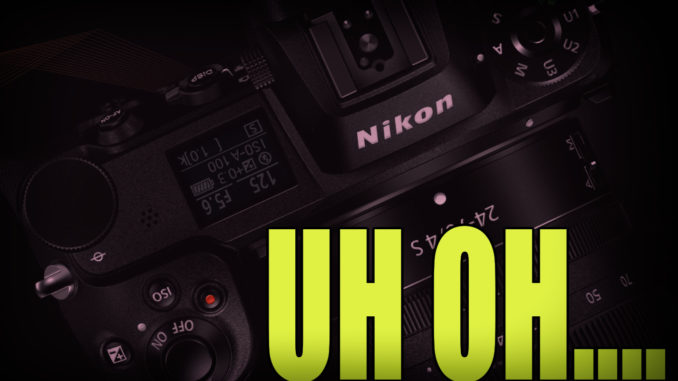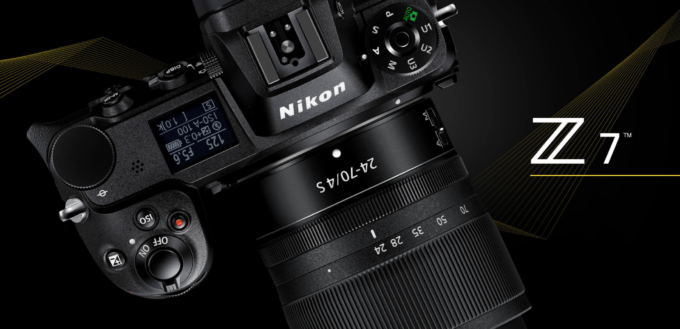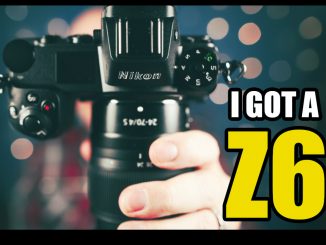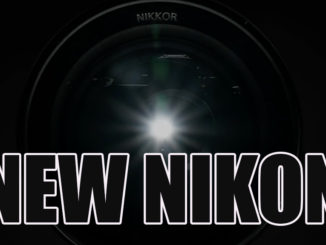
The new Nikon Z6 vs the Sony A7III. Where it fails and wins.
You can pre order the Nikon Z Series at B&H Photo HERE

The MIRRORLESS WARS BEGIN! Today Nikon announced (officially) the new Nikon Z6 and Z7 cameras. Basically two bodies aimed directly at the Sony A7III and A7RIII. Almost identical specs but in some areas the Nikons (for the same price as the Sony models) actually beat the Sony’s but in some areas they FAIL, and those fails are not small ones IMO. I love many things about these new Nikons and am thrilled that Nikon finally got serious in mirrorless but lack of lenses at launch (three lenses, nothing exotic), battery system and single card slot may turn some off. I will talk more about these models soon but see my thoughts below in a new video:





Yep, a grip is coming but you are correct. No contacts and no shutter release. I lost all interest in the Z series and almost lost all interest in the Canon after speaking behind closed doors with over 7 who have shot with it.
Joseph, on my D500 I had XQD and SD cards permanently in the slots, and to tell the truth I hardly ever used the XQD card, I had set it up when I got the camera to use the SD card and never bothered to change it, only time I remember swapping it to the XQD was one occasion when I left home and I had forgotten to replace the card in the camera slot after downloading photos to my pc.
I was shooting mostly birds in flight at max frame rate 10fps. and never had buffering issues. So I take your point about XQD being faster than SD, but I think that if you are using the faster SD cards there is little to worry about. Some cameras have small buffers, the D500 does not, no problems there for me.
Steve, just to clarify the grip issue, they are releasing a grip, but all the specs available online say there is no electronic connection in the base of the camera, so no shutter release or back button autofocus for this grip. Is this another design failure?
For me it was just another tick in the deficit column.
I agree with ColinB’s assessment.
I recently changed system to Sony, and so far completely satisfied with my decision.
I waited for the Z mount release then did the switch as I was underwhelmed at what Nikon’s mirrorless re-imagined really came down to in the end, 2 lack lustre cameras with nothing new and several stark deficiencies as regards to the cameras I had used in the past, as a long time satisfied Nikon user; D4s, D7000, D7200, D810, D500, all class leading cameras when they were launched, and I felt I would be stepping way down in performance if I went the Z mount route, also price is NOT competitive, if you factor in the price of an XQD card and reader approx £160, if you don’t have one already, do you? Add that to the retail price, body only with adapter of £2199, comes out at approx. £2359. Price doesn’t look too competitive now does it? Then you can add a lens if you like, and see ColinB’s comments for the price of those babies, because if your only reason for buying one of the new Z mount cameras is to use existing glass, then it’s not a compelling reason, is it? That’s all based on price, without discussing the down or Upsides of the Z mount and any competing camera.
Just saying!….
Or Leica M
The battery door is sealed (Sony’s are not), and they say it has D850 level weather sealing – which we’ve seen from the IR test is far better than the a7’s.
Well, even Canon buys Sony sensors, the 1-inch-sensors for their high-end compacts.
If Sony would remain the one and only sensor maker for the traditional camera market (not special industrial applications), then the competition would be lost and progress slow down. So all users, independently from any brand, should hope that Canon catches up. When Canon was leading in sensor technology about a decade ago, Sony was forced to catch up. Finally, we users profit mostly from a healthy competition.
The Nikon D750 is indeed a good camera especially with native Nikkor lens, the colors and overall image quality, for my eyes are better than my Sony 7iii and Sony/Zeiss lens.
Maybe for flowers….
I was excited to see the Nikon but for me, I would stick with Sony over Nikon if I had Sony glass. If I had more Nikon glass I would probably go to the Z series, as that seems to be why they made it, for existing Nikon users who have a glass collection. You have 12 lenses so the Z seems natural. Will reduce your size, will allow you to use your lenses and will have a higher quality EVF and LCD over your Sony. Nikon is going to release a battery grip for the Z so that will solve any battery issues.
So, I think sony a7iii win beacause sony a7iii have 693 af,powerful eaf and battery life biggest to the nikon z6.So all ways everything seen that a7iii’s picture shows deatails and z6’s picture don’t very clear show deatails I mean when the any pic doing zoom then no clear deatails.thankyou
But Nikon has great colors! For me it’s essential!
Hey Steve, first congrats on your site – a very rare example of honest, balanced and representation of photography and gear. So : Sony vs Nikon ? Not that easy. I use my decent Nikon collection (12 lenses collected over 15 years) now on D850 – although I don’t have the real high end tele primes. I am not a “pro” : not shooting for living but for excitement, and do a lot of family and friends stuff, even in my small home studio. There, the D850 cannot be conquered IMO….. Recently though I also do quite some birding for which I found my example of Nikon 200-500 very-very good, even with 1.4x teleconverter. The new 500 PF is also tempting…
Now, earlier this year I bought the Sony A7iii mostly for size and AF. First I wanted it for general lightweight FF travel camera, and I love it, but guess what, it gives great performance also for birding with the 100-400 (and the sony 1.4x). Generally I have more keepers with this combo than with the D850/200-500. I think that is quite a compliment for Sony, mostly due to its awesome AF. But the few real top photos are from the Nikon gear (although rare) – all due to reach and cropping potential of the D850 exceptional high res sensor. Before this Nikon announcement I was planning to slowly move over to Sony (next A9 with A7iii AF maybe ? ) and swap lenses/system. But now I can wait how Nikon will improve the Z AF glitches and then try the Z7 for portraits (face or eye AF) and wildlife (AF speed and AF lock on fast moving targets in whole sensor area). Cannot wait to see how this turns out – I prefer to keep only one system and need to stop (or slow down) burning money on this :). Any opinions on this ?
ONLY for the viewfinder which is different. It’s still a mirrorless camera in the traditional sense.
Thanks for the article; we would still like to hear more once you get a chance to “walk around” with one.
Do we know that Nikon’s weather sealing is better? I have heard speculation, but haven’t seen any tests.
Rangefinders have mirrors…
https://dehk.wordpress.com/2011/12/08/making-your-range-finder-brighter-diy/
I hope so and if I go by my experience with the way most of the press shoot these cameras at events, mostly all shoot in high frame rates which will yield MANY more shots than shooting single shots. So it may vary from 300 to 1000 depending on how one shoots. But if we go by the rating, it could have been better. For video it will eat that battery quickly. As for Sony doing the adapter thing, yes indeed they did and it sucked. I am glad they finally moved past this. My point is this…Sony already did it and make bette camera than the Nikon if we go by Z6 to A7III. Sure, some things are better on the Nikon (EVF, LCD) but mostly everything else is better on the Sony. Therefore, I do not see many SWITCHING to Nikon for this. Rather, Nikon fans who own glass and enjoy the Nikon brand of cameras will. Sony brought a ton of people over from Canon and Nikon and still do every day. It’s how they are killing it. Nikon did nothing here to convert Canon, Fuji or Sony users to switch to them. If they put in a better battery, had AF as good as Canon or Sony, had dual slots, kept the high res EVF and LCD and video specs, as well as added a swivel screen, we would have seen people going back to Nikon from Sony. They could have done that at the same price point as it would have been a smart move for the future. This is how Sony is sort of conquering the full frame mirrorless world right now. Offer amazing value for the money, and they are also masters at marketing via their Kando events, allowing anyone to come for a few days of shooting, testing their cameras, workshops, etc. The Nikon is a solid camera and it can be used to take gorgeous photos, in a smaller package but they needed something “WOW” here. Now we wait for Canon.
Yes indeed.
Well the Leica Q is a great start, but with a fixed lens. It is the only camera that I use now as my Nikon and Lumix M4/3 systems just don’t go with me anymore.
I agree. It’s always good to look at the big picture. I switched from a Nikon DSLR to M4/3 (Olympus) to reduce size and weight, and although my Pro 12-100 and 100-400 are far from being light, they are certainly much more compact and lighter than the Nikon equivalents would be. However, there are certainly times when I wish I had more dynamic range and that my E-M5 II could better handle high contrast situations and rich reds. But having said that, it seems that when you move to the FF mirrorless systems many of the size and weight advantages of switching to mirrorless are lost.
Leica already has a fullframe mirrorless, it’s called the M9, M240 or M10
Nikon unfortunately will not release mount specs to third party unlike Sony which released full details of FE mount to Sigma, Tamron etc. This means they’ll have to reverse engineer the Z mount. They may not bother and it might take a while if they do bother
I think it’ll be worth waiting for Canons FF mirrorless offering(s). Whilst the Nikons look like great cameras, they’re don’t seem like game changers. Of course both Nikon and Canon wont have the native lens lineup that Sony has built up (plus Sony has some stellar manual lenses from the likes of Zeiss and Voigtlander) so Sony could still win for now in terms of the more complete system.
My concern for Canon where video is concerned, they have their Cinema EOS line and, other than the 5DIII seem reluctant to give us a decent clean HDMI output (the 5DIII output wasn’t perfect) for use with external monitor/recorders like Atomos. Would they continue to compromise this on their mirrorless cameras? Considering what the competition offer, I’d like to think not. Maybe this is where Nikon could have the edge as they don’t have a professional cine cam line to protect, unlike Sony and Canon. If they offer a flip screen in their next update and continue to improve on the battery performance and colour profiles, it could be a winner for video. Panasonic seem to be leading the way for video in this regard but their cameras are only m43.
Overall, with Nikon in the game and Canon with us next year, this can only be a good thing for us consumers and the future of FF mirrorless.
Steve, believe we will find that original battery life estimate 330 to be incorrect I hope. As the senior staff member of DP review got double the shots with his Z camera sample. Your comments on the F adapter not fair as you explained Sony did the same thing in the beginning until more lens were available but there is big difference here; the Nikon adapter actually focuses the F lenses test by DP review rapidly. Where as Sony did not! The card slot is an issue hopefully corrected on future Z models.
Love your website Steve, been fan of yours very long time even though I am really not into Mirrorless cameras yet
Hey Huss where you been, ever hear of Leica SL ?
I think the Z mount itself may prove to be a big positive. In theory it should yield lens designs that deliver corner to corner sharpness even wide open. These first 2 bodies are definitely missing some features, but I think the Z system has some real potential. Let’s also see what Canon does in 2019 with their rumored FF mirrorless system. Competition is very good for all of us.
Looks like a great start for Nikon. Only one XQD is a little sad, but probably not a deal breaker for non-pros xQD is much faster than SD from my experience. I still have a Nikon F6 and some fast primes, so the 2nd gen Z6 might be tempting for me. Will certainly rent one for Lens Rentals when they come available. As I remember Sony did. It have the best lenses when they first release the A7. Exciting times! Cannot wait to see what Cannon will come with.
Once Leica finally brings out a FF mirrorless, we’ll be set.
Yeah, Nikon Rumors posted that it was a possiblity and then later removed it.
The confirmation bias with Sony shooters is funny. For years when people were banging on Sony’s battery life and that single, slow UHS-I card slot the faithful shouted about carrying more batteries because they’re light, and card failures are so rare. Now its a deal breaker, despite XQD being a far more robust format and CIPA battery ratings are a joke. I love my a7III, but once a few more Z lenses are in the wild, I’d take the Z6’s fatter grip, comprehensive weather sealing, 3.6m dot EVF and that 2.1m dot LCD with better touchscreen functionality. Plus its the only FF camera this side of the Sony Venice Cine cam that can output 10-bit 4k video – that’s something we’ll never see from Sony since they’ve drawn a clear line in the sand between the Alphas and the FS line.
Nikon getting into the game is good for all of us. I want to shoot Nikon just for the 28/1.4 G, the 14-30 is a great UWA range, the 2.8 zooms are coming next year, and I’m sure Voigtlander will be bringing Z mount versions of their lenses soon. By the time the Gen2 cams come, it should be a really good system. If Sony keeps the video capped at 100mbps in the mkIV cams, I’ll be shifting to the Zed mount in a couple years.
Hi Mike, you are exactly on point. My goal is to merge my DSLR and M43 into one. I went ahead and pre-order the Z6 :D, let see how it turn out. About that medium format sensor, I totally agree with you on that point but the fact that Sony can jammed that 35mm sensor in a 46mmish flange made me think Nikon might do something crazy ;), who know??
You make a lot of good points, I don’t see it either.
Well, this is pretty underwhelming! Expensive, untested, and limited glass are certainly reasons for me to rush right out and pre-order one (or two). Wake me up in about four years when there is a system to consider.
Exactly this. Sony is betting on two horses by also supplying tech to Nikon. The end goal is to beat Canon, with or without Nikon.
Once the Nikon mirrorless gets to much steam, you will start seeing Sony throttling the sensor tech. Nikon might have to wait 12 months to get the latest sensor etc…
The benefit of mirrorless is that you would be able to merge your DSLR and EM5 systems into one.
By the way, the 55mm inner diameter of the Z mount will not allow for a medium format sensor.
The addicts will have to buy one, but rational people? Not so much…
I was really really excited for these Nikon Mirrorless and single card slot kinda disappointed. I am currentyly own a D610, D800 24-70. 70-200, 85 1.4, and some Nikon Speedlight and thought of switch to Sony A7III, I think I will wait to see how the FTZ perform, as I really don’t want to liquidate all my glass and I really comfortable using the Nikon CLS. I’m still loving my Nikon FX DSLR and my EM5ii and don’t know if the switch is worth it. They size of these Z mount made me think there will be a possibility of Medium format sensor in this system in a very near future
I agree with you 100%, which is generally what I said. I was saying that for me, those were sort of, kind of, maybe dealbreakers. But praised it for everything else. It will sell well I predict but it’s VERY Sony A7III and A7RIII like spec wise. Will be a few years before lenses are a plenty but it’s good to see Nikon making a quality mirrorless camera, finally.
a) While I agree with you that battery life and a single XQD slot will be concerns, I don’t know that these will be deal breakers for everyone. It will purely depend on the photographer. It’s not ideal, but I have a feeling Nikon owners, who already have a D850 (which uses the same battery), won’t mind so much… They’ll probably buy extra batteries.
b)In regards to Z-mount lens quality, it’s probably not fair to judge these lenses and compare them to Sony’s selection, until the lenses are in the general public’s hands. Sony lenses are not terribly cheap either.
c) Adapted lenses are never as good as native lenses. The same applies to both Sony and Nikon.
This is welcome competition in the mirrorless space and it looks like a nice first attempt by Nikon but what I’m seeing with these Nikon cameras is essentially 2nd generation Sony performance (weak battery life, single memory card, smallish buffer, hobbled FPS, average AF and no Eye AF) for 3rd generation Sony pricing (and even more expensive on the Z7).
I also would miss that extra dedicated exposure comp dial that we have on the Sonys and early reports are that the Nikon’s two custom function buttons near the mount are awkward to access – especially if you have smaller fingers. Add to that the questionable two-step process to initiate AF tracking and I wonder if the ergonomics are really that special.
Yes, I’m firmly in the Sony camp as one of their Artisans but I would have a hard time going backwards to a previous generation of tech. I’m sure Nikon will iterate and improve – the market will demand it – but you would have expected them to come out of the gate on equal footing. Seems like
they are already playing catch-up.
No that’s not true it only takes one card.
The real decision here is for someone who doesn’t already have any skin in the game. Were I wanting to go full frame mirrorless, it is now a two horse race. Given my decades of previous Nikon use (no lenses currently), Nikon might very well be the more compelling choice. We’ll need to see them out in the wild first, to get a better take.
A completely different Sony division makes the sensors. The split was made to ensure that the sensor division could make good business decisions when it came to selling competitions their sensors. Likely Sony camera division would not want to hand their key competitor an important component.
I’m heavily invested in Sony full frame bodies and lenses. I don’t see anything in the Nikons that would tempt me to change. Also, I highly value Sony’s silent shutter for both people and wildlife. This seems like a decent start for Nikon, but not lust worthy at least for me. I agree with your anaysis of the features they could have included that would have made it much more appealing. I’m waiting to see what Canon does.
I thin in about 2 years we will have a near perfect mirrorless body from all manufacturers. Nikons first real outing here looks fantastic with just a couple of flaws really. They have always been pricey though, even with the Nikon 1 system but while I point out the flaws I think it still appears to be a fantastic camera.
Sounds like the Z7 would be great for you actually. If I had a collection of Nikon lenses, I would be considering it for sure.
Yes indeed.
I have seen nothing on it taking 2 SD cards, yet..but if true that would change a lot for many.
Yep A7III or A9. Id go A7III actually.
Steve:
If you were to buy 1 mirrorless camera for all purpose photography, including wildlife and birds in flight, I assume you would eliminate the new Nikon Z6 and Z7 and stick with the Sony A9 or A7III. It sounds like the sticking with Sony seems to be the place to be. Your thoughts?
Hey Steve, for what it’s worth, the adapter is $249 and $149 if ordered with either body. Also, from what I’ve read, while the card slot only takes 1 XQD card, it will take two SD cards. Not sure if that part is accurate or not.
The new 35mm Z lens is $320 more costly than the current 35mm F lens (at B&H). I guess more new Blue Crystals. The F to Z adapter seems a little over priced. That could be a sticking point to get current Nikon shooters to get an extra camera body
Otherwise the Z6 and Z7 seem OK but it would be good to get some hands-on feedback later this year once these start getting into a variety of users hands.
The Z7 is tempting for me. Just how tempting I haven’t decided yet. I shoot landscape stills and never shoot video. I always manual focus. And I’ve kept a bunch of great F-mount glass from the days when I used to shoot Nikon. Today I use those lenses with an adapter on my Sony A7rII with (mostly) good results. But the adapters are a little funky and I have occasional light falloff issues with some lenses at wider apertures. So I’d like to try a Z7 with the FTZ adapter, before I decide, to see if it’s worth the $3,546.90 that B&H charges for the combo. It’s a high bar and I suspect I’ll come away with my piggy bank intact.
For me, if we have a great compact body then we also need at least one general more compact lens like the 35mm F2.8 that Sony offer.
Let’s hope than comes later. Otherwise 35mm AFD plus D750 gives a lighter more compact option when body + lens are considered.
Your neck must have been sore after this.
Thanks for the first impressions.
One of the “pluses” of the Sony is that there is excellent Sigma glass available in the native Sony mount.
When both Nikon and Sony are using sensors made by Sony, it ain’t a war.
If Sony did not want Nikon to succeed and sell as many Z6 /Z7 as possible, they wouldn’t make the sensors. Simple.
Easy on the hyperbole. If there is a mirrorless “war” it will happen when Canon show up.
Steve, thanks for your clear and honest thoughts!
Am I missing something? Here in the UK, you’re looking at £2,200 for the Z6 and adapter as a package. The 35 and 50 primes are a whopping £850 and £600 respectively and the f4 zoom is £1,000. Or you could buy a 24mp D750 for £1,350 (or a lightly used one for around £1,000) and get much better battery life, 2 card slots and access to dozens of NATIVE F mount lenses at a fraction of the cost of the 3 (wow 3…!) available Z mount lenses. And since the Z6 is only 75 grams lighter than the D750, the famous mirrorless weight saving is not remotely meaningful. And that’s before you get to the fact that the Z lenses are actually heavier than their F mount equivalents. For example, the 50 1.8 is 415g compared to 185g for its F mount equivalent – are the components made of lead? The only conceivable argument for the Z6 over something like the D750 is if video matters to you. But then you (and your wallet) would be better off buying something used from Panasonic to cover your video needs and you’d still be spending less than you would getting into the Z system. Maybe it’s just me, but paying twice as much for something just because it’s mirrorless (and shiny and new) is just insane.